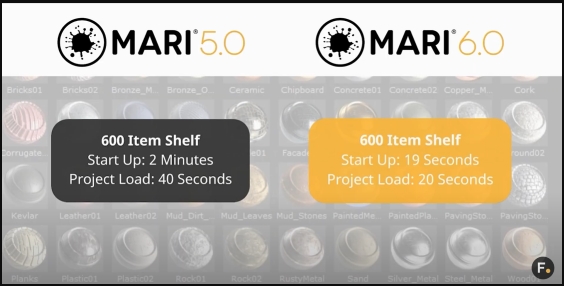What's New in Mari 6
Mari 6 has several new features and feature enhancements in addition to bug fixes. This page documents the new features, and links to the appropriate page of the online help so you can get the information you need to start working with the new features right away. To read about bug fixes and feature enhancements, navigate to a specific release.
Note: See the navigation bar on the left for links to specific release notes by version.
Mari 6.0
Extended USD Support
Continuing our USD journey, Mari 6 provides even more control of your USD exports. You can now export the USD Look with the appropriate shader bindings without having to go through an external Lookdev DCC (digital content creation) tool. In addition, with artists now having the ability to utilize Selection Groups in order to create material assignments on the geometry, it is even easier to get ground truth render feedback to facilitate verifying looks for dailies.
USD Look Export
Mari's USD export workflows have been extended to allow you to export a full USD Look file that contains both a USD Preview Surface shader and your chosen vendor shader. Mari 6 ships with export context solutions for Arnold (Arnold Standard Surface), RenderMan (PxrSurface), USD Preview Surface, and Principled BRDF, which can be used as readily available examples on how to generate a complete USD Material right from the Mari project itself.
See Exporting USD LookFiles and Assemblies with Material Assignments for more information.
USD Material Assign
Building upon work completed in Mari 5, Mari 6 encourages the use of interactive selection group tools in order to drive USD face set-based material assignments. You can choose selection groups in the material assignment in order for materials to automatically assign to the correct face sets within the exported USD look, removing the need to reassign materials to in your Lookdev DCC. You can then use Mari's USD Look exports to get ground truth render feedback, which is perfect for verifying looks for dailies.
See Assigning Your Materials to Selection Groups for more information.
TX Post Process Command
By default, Mari ships with Post Process Commands for utilizing Arnold and Renderman texture conversion tools in order for images to be converted to .tx or .tex files right after Mari’s export has completed. This gives you the ability to render the textured USD asset with the appropriate render shader bindings without having to convert the textures manually. The command can be edited to use any of the appropriate conversion tool commands from within Mari, reducing unnecessary pipeline friction.
Roller Brush Tool
The Roller Brush tool adds a new painting mode that allows you to paint a tileable image that follows the direction of the brush stroke. For example, you can create seams or decals on a character’s clothing without having to manually line up each tileable texture, one by one, to mimic a brush stroke.
See Paint Continuous, Repeating Textures with the Roller Brush for more information.
Shelf Improvements
Through our collaboration with Weta, we have been able to bring you some amazing optimizations to Mari’s Shelf performance. With the addition of our new Python Shelf Item, the Shelf has never been more powerful or more collaborative.
Python Shelf Items
We’ve introduced a new Python Shelf Item that facilitates collaboration between artists using our powerful Python API. You can store Python scripts in shelves which can be executed by double-clicking on the item itself. In addition, the script can be edited inside the shelf and you can change the default thumbnail to something that fits more with the functionality of the script itself.
See Run Custom Python Scripts Directly from Shelves for more information.
Shelf Performance Optimization
Shelves have been separated from the main configuration file and are now saved out to separate files. Thumbnails are now embedded into the shelf data, rather than stored as separate images on disk, which greatly increases project load times. Sharing shelves between artists is even easier than before, facilitating collaboration while reducing unnecessary time spent on start up.

Teleport Nodes
The Teleport nodes help organize your node graph and reduce pain points from repetitive actions, improving your quality of life. Teleport clarifies your node graph by tidying up messy node connections making it easy to read for you and other artists if they pick up your work. You can also quickly reuse elements, such as textures and masks, in other areas of the node graph without creating long or overlapping connections.
See Teleport Broadcaster and Teleport Receiver Nodes for more information.
VFX Reference Platform CY2022
Mari's third-party libraries have been upgraded to the CY2022 versions specified by the VFX Reference Platform. See Third-Party Licenses for a full list of third-party libraries.
